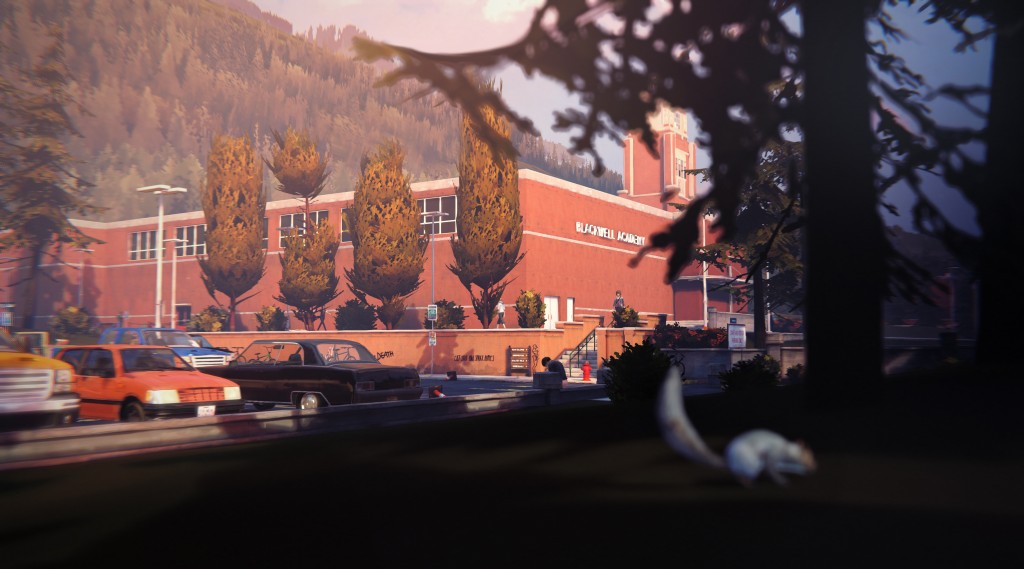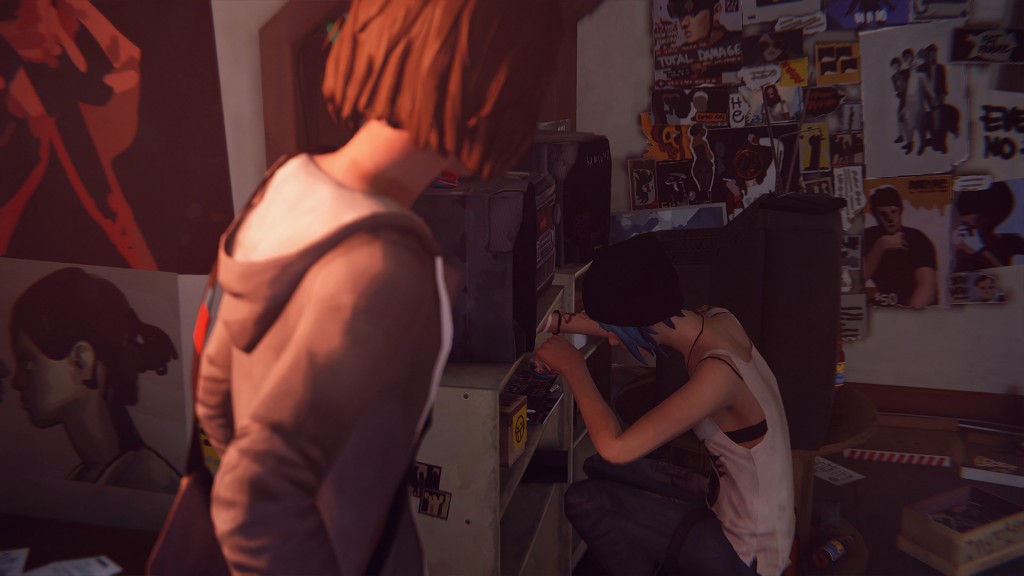But do they succeed? It’s a pretty mixed bag, as it turns out. You start out (after your initial dream/premonition encounter) in a photography class. Aside from the outrageously small class size, it seems realistic. There are photos on the wall, photography-related items on shelves, and protagonist Max herself has all her stuff spread out over the desk. Then, when it’s time to get up and move about, the mirage fades. You can look at a great deal of items within the room, but what you can view feels very regimented. A crumpled up piece of paper insulting another student lies on the ground. Then there’s a little declaration of love scrawled on a desk. Aspects like these seem specifically made to give the impression of a “high school experience” without real authenticity.
The school itself is littered with posters and students standing around all day, but where is the more expected hustle and bustle? We see one kid getting teased, and others simply standing around on their phones. Ah, yes, of course both these things are so prevalent in schools! Again it feels more like a stage play than reality. Some of this oddness also comes from Blackwell Academy itself which is apparently a very small, elite high school with far more of a private college vibe than expected. Obviously these choices were made to emphasize gameplay. If there were too many people out and about it would be hard to know who to speak to. If the world had far more doodads to look at you’d never manage to leave.
But I’m someone who loves examining in-game environments. As such, it felt like a big letdown to realize there were usually not nearly as many objects to look at as you might think. A big chunk of these ended up being posters. I hope they rely on it much less in future episodes. Simply having a lot of funny/sad/weird posters does not make your world real. It simply provides a ton of text to sift through which makes you desire to actually SEE anything referenced. For example, I’d love to see the groups mentioned (beyond the eponymous Vortex Club which will almost certainly be showcased in a future episode). Instead players are teased with possibilities which will likely never come to pass.
It’s not all doom and gloom for Life is Strange, though. It’s once you get out of that accursed campus that things start to look up from an environmental perspective. This turning point is when Max has a chance run-in with her old friend Chloe. After the two drive off in her antiquated truck they reach what, from the outside, appears like a total suburban tract house. Once inside – in Chloe’s room – I feel that the game’s ‘set design’ really begins to shine. Inside is a total whirlwind of a room with junk strewn everywhere and posters taking control of all wall space. Unlike the posters everywhere else in game, these cannot all be viewed. They’re not there to provide false substance but simply give players a feel for Chloe’s tastes.
Befitting with its gameplay, players are then asked to look through this messy place in order to find a music CD. This time, the gameplay and environment do work together to create something more interesting than early on. Yes, you’re searching because that’s what much of the gameplay devolves into, but it makes sense to search. Max has not been in this room for years, and even if she had there is just too much stuff cluttered everywhere. It’s a visually noisy environment, but one that inspires searching. In fact, the search liberates players. At least in my case I felt too confined by social cues to simply start digging through Chloe’s things with her in the room. However, once she basically told me to I had a field day.
Unlike almost everything else in the game so far, this room just felt real. I for one would admit to a huge poster obsession in my teenage years as well as not being a neat freak. These similarities also helped give Chloe more depth. After all, is she really the outcast she paints herself to be (blue hair and all)? Or is this a coverup for her internalized struggles? Obviously we’ll learn more as the story proceeds in its later episodes but we’ve already got hints. Some are provided via dialogue but many are defined through scenery.
To see both “good” and “bad” staging presented over the course of two hours is a bit odd. For all its trying, the school just doesn’t feel real – and that’s not just because it is such a different world from my own high school experiences. Some could chalk that up to the developers likely not being entirely cognizant of the teenage experience anymore, but then how could they create such an effective character environment with Chloe’s home? Whatever the case may be, Dontnod definitely have it in them to create storied landscapes and have already proven as much. They just need to continue to explore beyond Blackwell Academy – beyond this ‘sitcom reality’.
Life is Strange is the selection for the January 2015 “Not Crowdfunded, But…” series. You can read more Life is Strange articles here.






